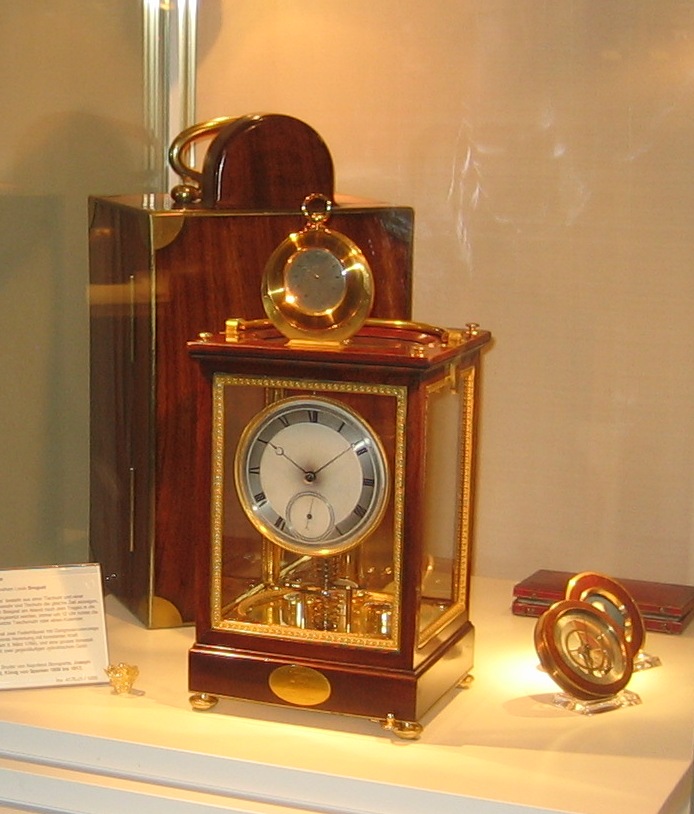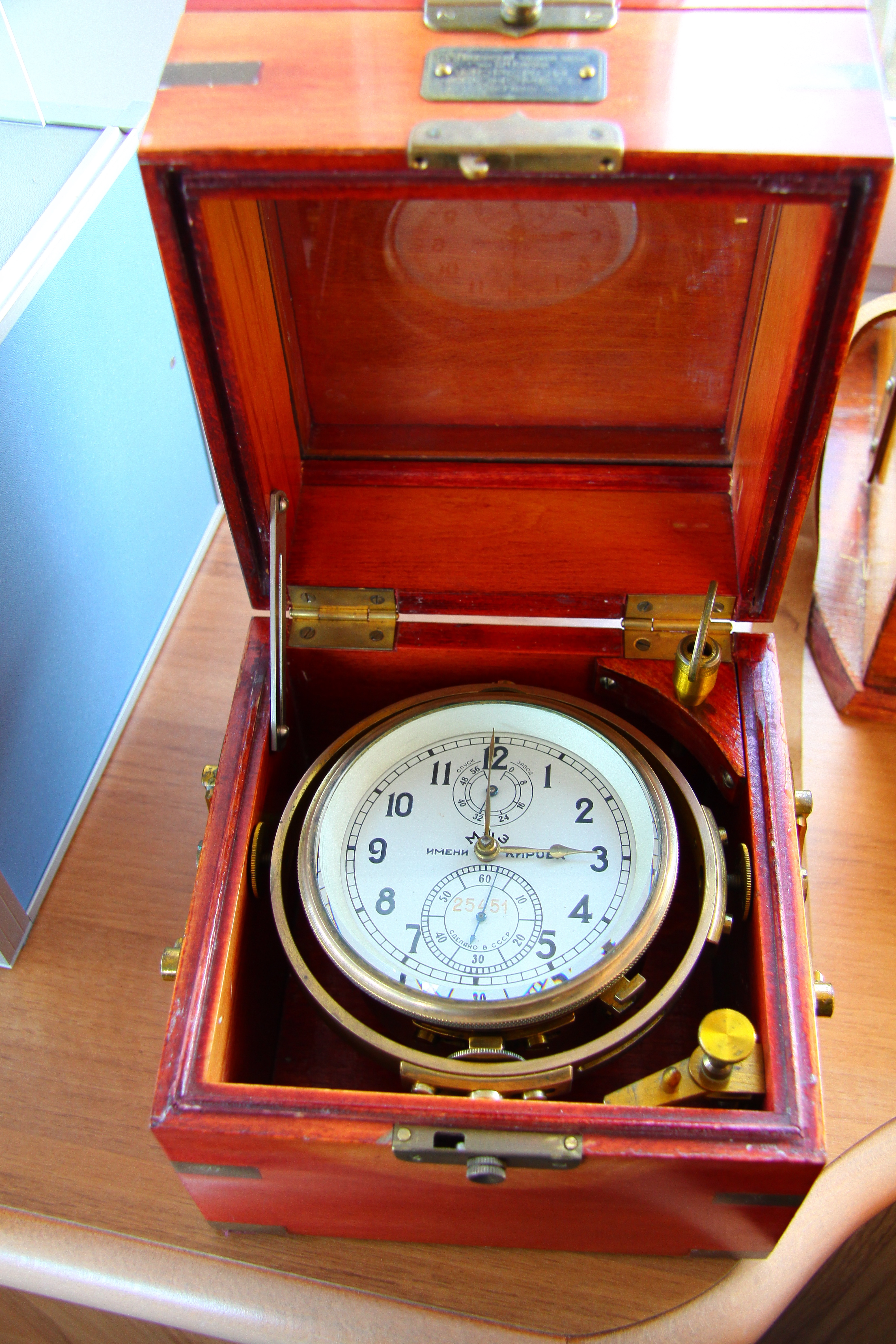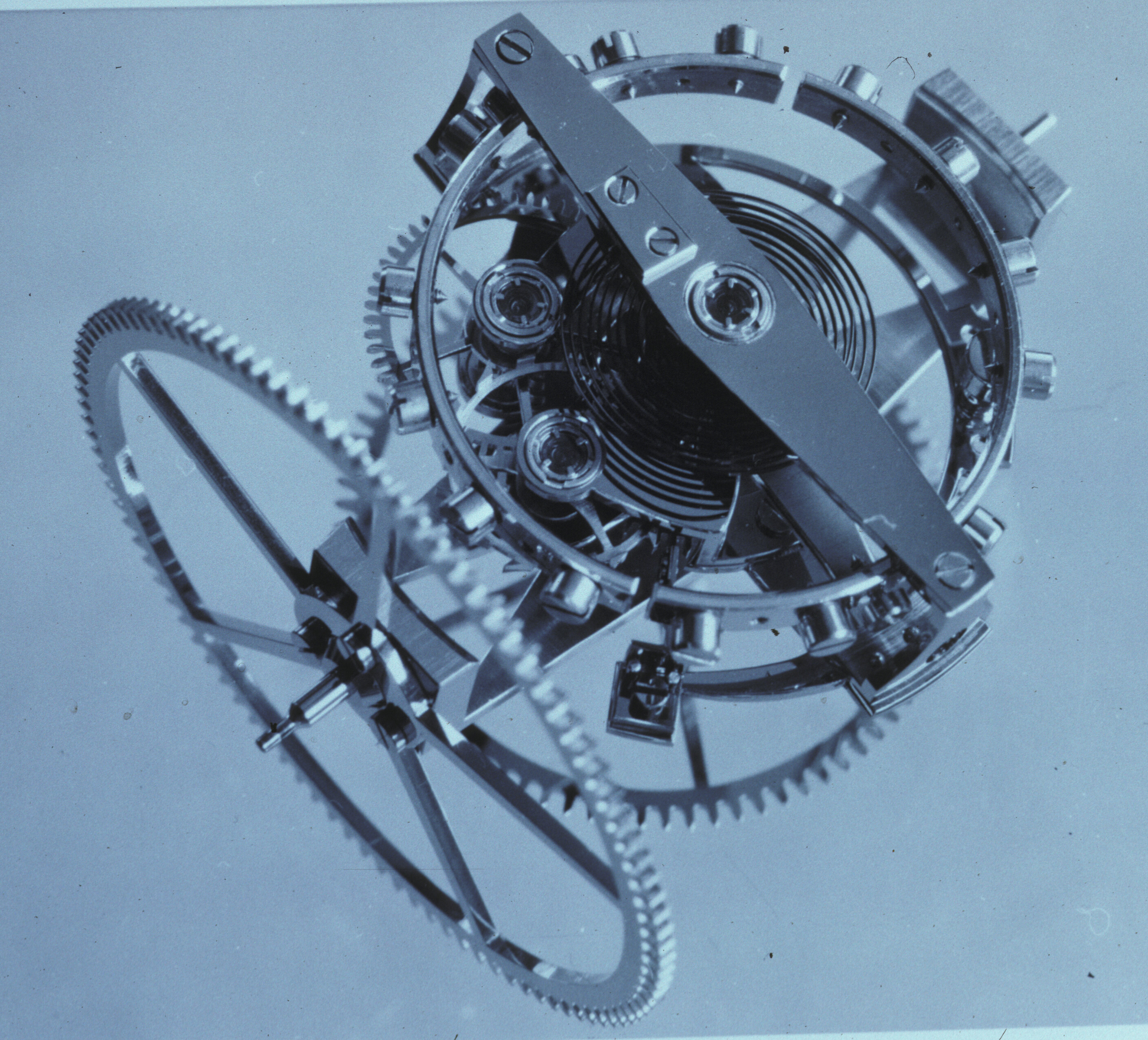|
Echappement Naturel
The échappement naturel was the invention of Abraham-Louis Breguet, one of the most eminent watchmakers of all time. Following the introduction of the detent chronometer escapement with a temperature compensated balance, very close rates could be achieved in marine chronometers and to a lesser degree in pocket chronometers. This achievement was due, other things being equal, to the minimal interference with the balance during unlocking and impulse. A further key advantage of this escapement was that there was no need for oil on the escapement's working surfaces and hence no deterioration in the friction between the working surfaces as the oil aged. A drawback was that the detent escapement as it was used in pocket chronometers was prone to stopping as a result of motion. Most escapements are capable of being stopped by a sudden movement but the detent escapement gives an impulse to the balance only when it is moving in one direction. The escapement is therefore not self-starting. Th ... [...More Info...] [...Related Items...] OR: [Wikipedia] [Google] [Baidu] |
Abraham-Louis Breguet
Abraham-Louis Breguet (10 January 1747 – 17 September 1823), born in Neuchâtel, then a Prussian principality, was a horologist who made many innovations in the course of a career in watchmaking industry. He was the founder of the Breguet company, which is now the luxury watch division of the Swiss Swatch Group. In his lifetime he was considered the leading watchmaker of his day, and he built up a clientele that included many leading public figures and members of the European nobility. Alongside his friend and contemporary John Arnold, Breguet is now widely acknowledged as one of the greatest horologists of all time. One of his famous ancestors was Jean Breguet (who died in 1593) a Protestant pastor in Neuchâtel very much influenced by the ideas of John Calvin. Life Breguet was born in Neuchâtel to Jonas-Louis Breguet and Suzanne-Marguerite Bolle. Breguet's father died in 1758 when he was ten, and his formal schooling ended when he was 12. Breguet's mother remarri ... [...More Info...] [...Related Items...] OR: [Wikipedia] [Google] [Baidu] |
Escapement
An escapement is a mechanical linkage in mechanical watches and clocks that gives impulses to the timekeeping element and periodically releases the gear train to move forward, advancing the clock's hands. The impulse action transfers energy to the clock's timekeeping element (usually a pendulum or balance wheel) to replace the energy lost to friction during its cycle and keep the timekeeper oscillating. The escapement is driven by force from a coiled spring or a suspended weight, transmitted through the timepiece's gear train. Each swing of the pendulum or balance wheel releases a tooth of the escapement's ''escape wheel'', allowing the clock's gear train to advance or "escape" by a fixed amount. This regular periodic advancement moves the clock's hands forward at a steady rate. At the same time, the tooth gives the timekeeping element a push, before another tooth catches on the escapement's pallet, returning the escapement to its "locked" state. The sudden stopping of the esc ... [...More Info...] [...Related Items...] OR: [Wikipedia] [Google] [Baidu] |
Marine Chronometer
A marine chronometer is a precision timepiece that is carried on a ship and employed in the determination of the ship's position by celestial navigation. It is used to determine longitude by comparing Greenwich Mean Time (GMT), or in the modern world its successor Coordinated Universal Time (UTC), and the time at the current location found from observations of celestial bodies. When first developed in the 18th century, it was a major technical achievement, as accurate knowledge of the time over a long sea voyage was vital for effective navigation, lacking electronic or communications aids. The first true chronometer was the life work of one man, John Harrison, spanning 31 years of persistent experimentation and testing that revolutionized naval (and later aerial) navigation and enabling the Age of Discovery and Colonialism to accelerate. The term ''chronometer'' was coined from the Greek words '' χρόνος (chronos)'' (meaning time) and ''meter'' (meaning measure) in 1713 by ... [...More Info...] [...Related Items...] OR: [Wikipedia] [Google] [Baidu] |
Lever Escapement
The lever escapement, invented by the English clockmaker Thomas Mudge in 1754 (albeit first used in 1769), is a type of escapement that is used in almost all mechanical watches, as well as small mechanical non-pendulum clocks, alarm clocks, and kitchen timers. An escapement is a mechanical linkage that delivers impulses to the timepiece's balance wheel, keeping it oscillating back and forth, and with each swing of the balance wheel allows the timepiece's gear train to advance a fixed amount, thus moving the hands forward at a steady rate. The escapement is what makes the "ticking" sound in mechanical watches and clocks. Invention The lever escapement was invented by British clockmaker Thomas Mudge around 1754, and improved by Abraham-Louis Breguet (1787), Peter Litherland (1791), and Edward Massey (1800). Its modern ("table roller") form was developed by George Savage in the early 1800s. Since about 1900 virtually every mechanical watch, alarm clock and other portable tim ... [...More Info...] [...Related Items...] OR: [Wikipedia] [Google] [Baidu] |
Figure 6
Figure may refer to: General *A shape, drawing, depiction, or geometric configuration *Figure (wood), wood appearance *Figure (music), distinguished from musical motif *Noise figure, in telecommunication *Dance figure, an elementary dance pattern *A person's figure, human physical appearance Arts *Figurine, a miniature statuette representation of a creature *Action figure, a posable jointed solid plastic character figurine *Figure painting, realistic representation, especially of the human form *Figure drawing *Model figure, a scale model of a creature Writing *figure, in writing, a type of floating block (text, table, or graphic separate from the main text) * Figure of speech, also called a rhetorical figure *Christ figure, a type of character * in typesetting, text figures and lining figures Accounting *Figure, a synonym for number *Significant figures in a decimal number Science * Figure of the Earth, the size and shape of the Earth in geodesy Sports *Figure (horse), ... [...More Info...] [...Related Items...] OR: [Wikipedia] [Google] [Baidu] |
Diagram Of Echappement Naturel By Breguet
A diagram is a symbolic representation of information using visualization techniques. Diagrams have been used since prehistoric times on walls of caves, but became more prevalent during the Enlightenment. Sometimes, the technique uses a three-dimensional visualization which is then projected onto a two-dimensional surface. The word ''graph'' is sometimes used as a synonym for diagram. Overview The term "diagram" in its commonly used sense can have a general or specific meaning: * ''visual information device'' : Like the term "illustration", "diagram" is used as a collective term standing for the whole class of technical genres, including graphs, technical drawings and tables. * ''specific kind of visual display'' : This is the genre that shows qualitative data with shapes that are connected by lines, arrows, or other visual links. In science the term is used in both ways. For example, Anderson (1997) stated more generally: "diagrams are pictorial, yet abstract, representat ... [...More Info...] [...Related Items...] OR: [Wikipedia] [Google] [Baidu] |
Tourbillon
In horology, a tourbillon (; "whirlwind") is an addition to the mechanics of a watch escapement to increase accuracy. It was developed around 1795 and patented by the Swiss-French watchmaker Abraham-Louis Breguet on June 26, 1801. In a tourbillon the escapement and balance wheel are mounted in a rotating cage, with the goal of eliminating errors of poise in the balance giving a uniform weight. Tourbillons are still included in some modern wristwatches, the mechanism is usually exposed on the watch's face to showcase it. Types of tourbillon Single axis tourbillon Patented by Breguet in 1801, the single axis tourbillon minimizes the difference in rate between positions caused by poise errors. The tourbillon was invented to complement the split bi-metallic balance which was inherently difficult to poise. In the most common implementation of this, the tourbillon carriage is carried by the fourth pinion, within a stationary fourth wheel. The escape pinion is engaged with this ... [...More Info...] [...Related Items...] OR: [Wikipedia] [Google] [Baidu] |
ébauche
(loanword from French, meaning blank, outline or sketch) is a term used in art to denote the first preliminary underpainting or quick sketch in oils for an oil painting. Horology, clockmaking and watchmaking appropriated the term ébauche to refer to an incomplete or unassembled watch movement and its associated components. The French term is regularly used by English-speaking artists and art historians, as well as horologists and hobbyists. Art One early criticism of Impressionist painting was that its practitioners sought to elevate the status of the ébauche to the level of finished painting. Horology Until about 1850, the watchmaker’s ébauche consisted of two plates with pillars and bars, the barrel, fusée, index, pawl and ratchet-wheel, along with a few assembling screws. These parts were all roughly filed and milled. The steel and brass were manufactured in a special workshop. The ébauche was finished by watchmakers in a finishing shop. The (literally "assort ... [...More Info...] [...Related Items...] OR: [Wikipedia] [Google] [Baidu] |
Duke Of Infantado
Duke of the Infantado ( es, Duque del Infantado) is a Spanish peerage title that was granted to Diego Hurtado de Mendoza y Figueroa, son of Íñigo López de Mendoza, 1st Marquis of Santillana, by the Catholic Monarchs, Ferdinand II of Aragon and Isabella I of Castile, on 22 July 1475. The Dukes of the Infantado remained an important family throughout Spanish history. The family counts seven knights in the Order of the Golden Fleece and one Prime Minister of Spain (the 13th Duke). Diego Hurtado de Mendoza built the New Castle of Manzanares el Real. Later the seat of the Dukes of the Infantado moved to the ''Palacio del Infantado'' in Guadalajara. List of holders House of Mendoza * Diego Hurtado de Mendoza, 1st Duke of the Infantado (1415/7–1479). * Íñigo López de Mendoza y Luna, 2nd Duke of the Infantado (1438–1500). * Diego Hurtado de Mendoza, 3rd Duke of the Infantado (1461-1531), „El Grande“. * Íñigo López de Mendoza, 4th Duke of the Infantado (1493� ... [...More Info...] [...Related Items...] OR: [Wikipedia] [Google] [Baidu] |
Coaxial Escapement
The coaxial escapement is a type of modern watch escapement mechanism invented by English watchmaker George Daniels in 1976 and patented in 1980. It is one of the few watch escapements which have been invented in modern times and is used in most of the mechanical watch models currently produced by Omega SA. History During the quartz crisis, English watchmaker George Daniels accepted a commission from American industrialist and watch collector Seth G. Atwood to create a timepiece that would fundamentally improve the performance of mechanical watches. As a result, Daniels invented the coaxial escapement in 1974 and patented it in 1980. The ''Atwood watch'' for Seth G. Atwood was completed in 1976. Technical overview The coaxial escapement is a modification of the lever escapement with some features of the detent escapement. One of the few advances in escapement design which have been adopted since the invention of the lever escapement by Thomas Mudge in the 18th century, the ... [...More Info...] [...Related Items...] OR: [Wikipedia] [Google] [Baidu] |
Clocks
A clock or a timepiece is a device used to measure and indicate time. The clock is one of the oldest human inventions, meeting the need to measure intervals of time shorter than the natural units such as the day, the lunar month and the year. Devices operating on several physical processes have been used over the millennia. Some predecessors to the modern clock may be considered as "clocks" that are based on movement in nature: A sundial shows the time by displaying the position of a shadow on a flat surface. There is a range of duration timers, a well-known example being the hourglass. Water clocks, along with the sundials, are possibly the oldest time-measuring instruments. A major advance occurred with the invention of the verge escapement, which made possible the first mechanical clocks around 1300 in Europe, which kept time with oscillating timekeepers like balance wheels., pp. 103–104., p. 31. Traditionally, in horology, the term ''clock'' was used for a striki ... [...More Info...] [...Related Items...] OR: [Wikipedia] [Google] [Baidu] |




